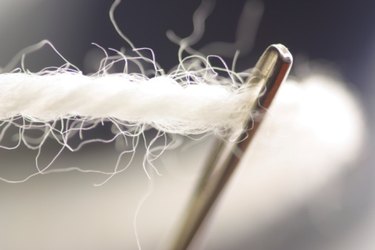
Traditional quilt making entails stitching three layers together in a decorative stitch pattern. The bottom and top layers are fabric, and the center layer is batting. Tying the quilt is an effective and time saving alternative to traditional stitchery. Tying a quilt consists of placing a series of knots at specific intervals throughout the quilt surface. The knots can be on the top or on the bottom at the quilter's discretion. A variety of needles are appropriate to tie a quilt. The specific needle depends on the type of thread the quilters chooses.
Embroidery Needle
Video of the Day
Quilters may wish to coordinate the knot color with a particular color from the quilt top. Embroidery thread comes in the variety of colors needed for this coordination. Three to six strands of embroidery thread are strong enough to hold the quilt layers securely. Select a large eye embroidery needle to accommodate the number of threads chosen. The tapered design of the embroidery needle allows the thread to follow through the fabric without resistance.
Video of the Day
Curved Tapestry Needle
Quilters who select knitting yarn for the knots may use a curved tapestry needle. The eye is large enough to accommodate the thick yarn. The curve of the needle makes it easier to work the quilt from one side without the need to turn the quilt back and forth. The quilter inserts the curved tapestry needle from the top to the underneath then rocks the tip upward. The curve brings the yarn back to the top at the same interval each time. People with arthritis or limited hand dexterity may find the curved tapestry needle more comfortable.
Darning Needle
The darning needle also accommodates thick knitting yarn and coarse crochet yarn. Darning needles are straight but people who have experience manipulating the needle can work the quilt from one side. The thick darning needle is strong and is not easily bent. The quilter inserts the darning needle from the top until about ¼-inch of the needle emerges underneath. The quilter rocks the needle at this point to reinsert the tip into the fabric and pull it along with the yarn through the top.
Number 9 Quilting Needle
The number 9 quilting needle is the largest needle used for quilting. The needle's large eye accommodates thin crochet thread used to tie knots in the quilt. The strong needle body allows the quilter to move insert the needle through the top layer for exit underneath. Because crochet thread is thicker than typical hand quilting thread, the number 9 needle does not work well for rocking as other needle types. The needle works well when pulled all the way through the layers, then reinserted in the bottom to come back through to the top.